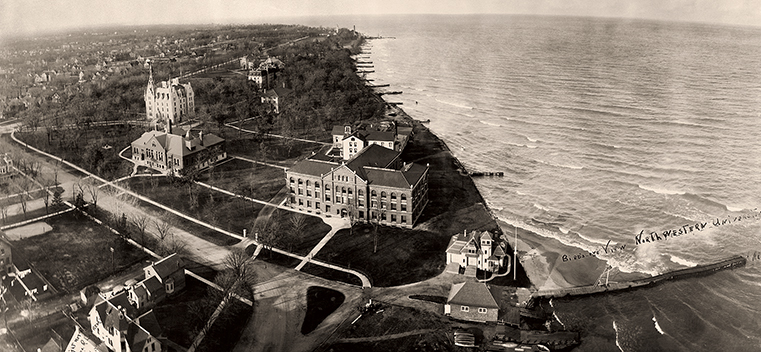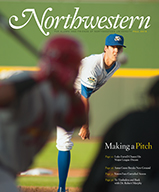
Then: Kite Click
Tell us what you think. E-mail comments or questions to the editors at letters@northwestern.edu.
Find Us on Social Media
Pioneering aerial photographer George R. Lawrence captured images of Northwestern, Chicago and beyond.
“Considerable interest was shown yesterday afternoon in a series of nine kites, which were flying just south of the campus,” reported the Northwestern student newspaper on Nov. 1, 1907.
The commotion was caused by George R. Lawrence. The University had hired the famed Chicago photographer to capture a bird’s-eye view of the University. Using his aerial photography technique, Lawrence flew nine kites above south campus, with a camera suspended from the highest one. He used a timed exposure to capture images of campus that were used in advertising materials.
Lawrence, a former farm boy, launched his photography company in the late 1890s with the slogan “The hitherto impossible in photography is our specialty.” He started in aerial photography by attaching a flimsy cage to a balloon. During one flight in 1901, Lawrence was more than 200 feet above Chicago when the cage separated from the balloon, and the photographer and his camera fell out of the sky. Luckily, telephone and telegraph wires broke his fall, likely saving his life.
Shortly thereafter he created the newer, safer kite technique that he called a “Captive Airship.” To keep the 49-pound camera aloft, Lawrence used as many as 17 kites with bamboo poles for stabilization and a steel piano wire to carry electric current to release the camera shutter. After taking the photos, Lawrence would deploy a parachute to bring his equipment safely back to the ground.
Lawrence’s photography also garnered attention when he built the world’s largest camera to take photographs of the Alton Limited Locomotive. The 1,400-pound Mammoth camera required up to 15 men to operate it. The locomotive images won the Grand Prize of the World for Photographic Excellence at the Exposition Universelle, the world’s fair in Paris in 1900. Lawrence later used his aerial technique to photograph San Francisco in ruins after the 1906 earthquake and fire, images that ran in newspapers around the world and earned him $15,000.
After his success with unmanned aerial photography, Lawrence turned his attention to aviation design, for which he received nearly 100 patents. By 1910 he had left photography behind.
The Northwestern photograph, part of the Library of Congress’ Panoramic Photograph Collection, shows the still-standing Fisk Hall, University Hall and Annie May Swift Hall, along with the now-razed Fayerweather Hall of Science and Old College, the first Northwestern building ever constructed. The house-like building on the lakeshore was the U.S. Life-Saving Station, the first such station built on Lake Michigan. The original boathouse, constructed in 1871, stood beside it. This picture shows campus more than half a century before the creation of the lakefill, which expanded the University’s physical size by 84 acres.



 Facebook
Facebook Twitter
Twitter Email
Email


